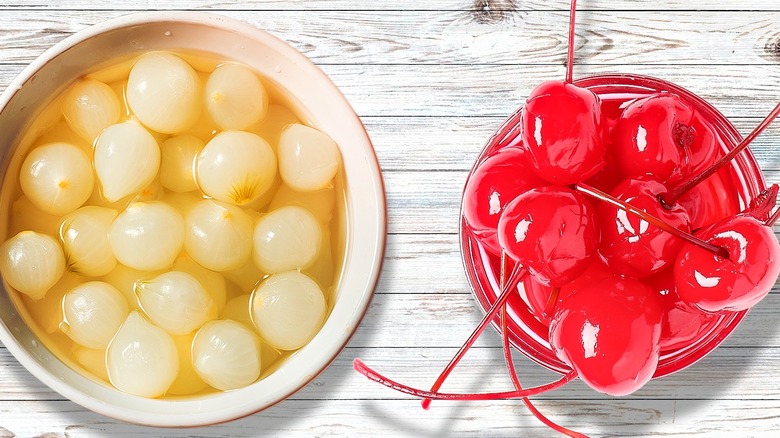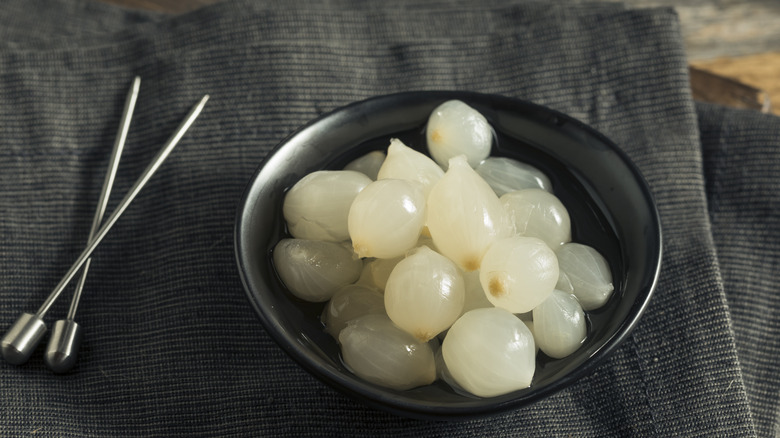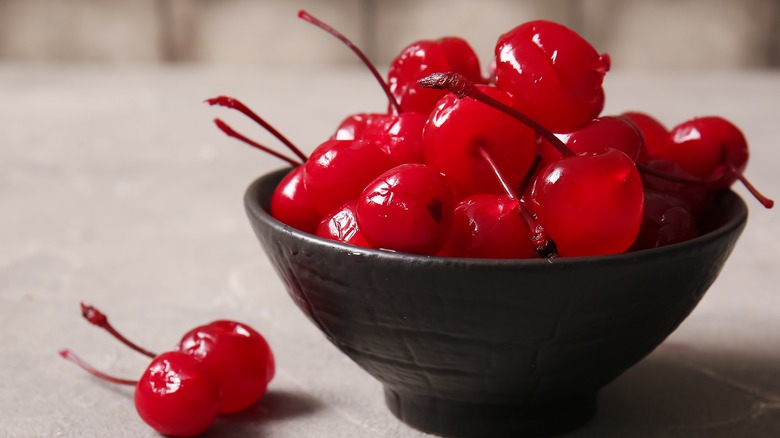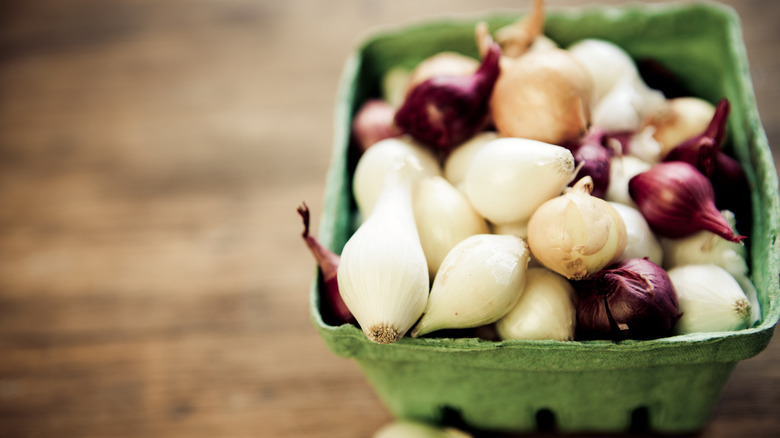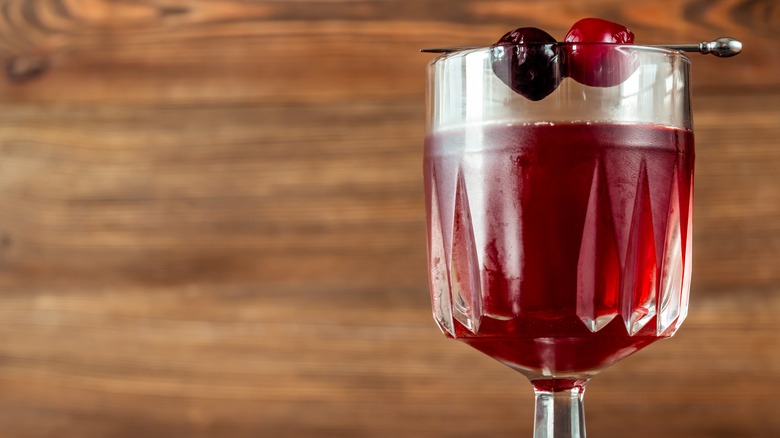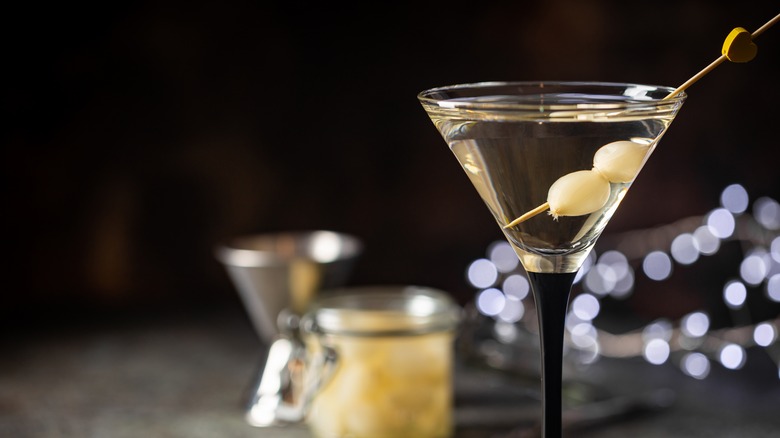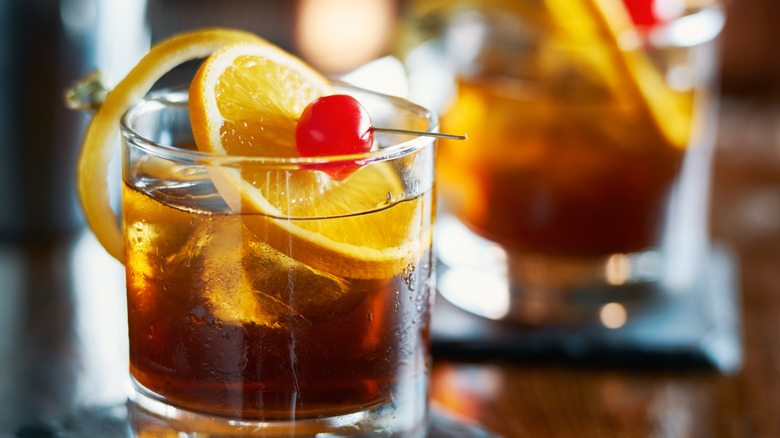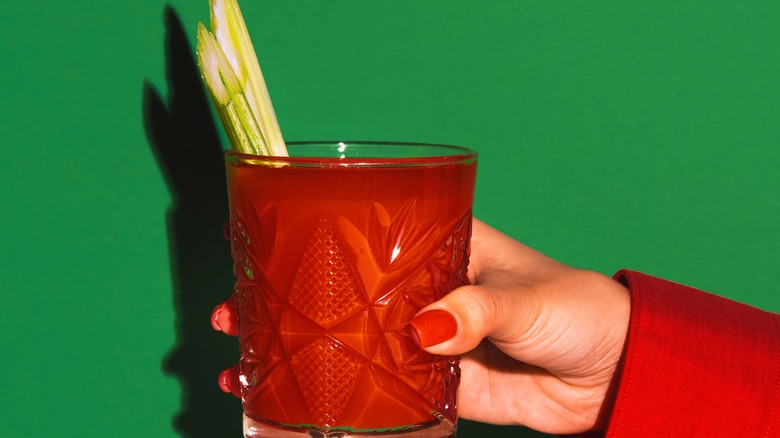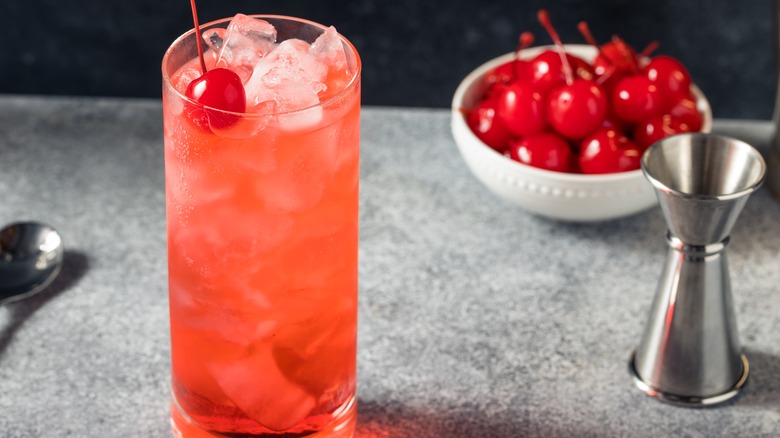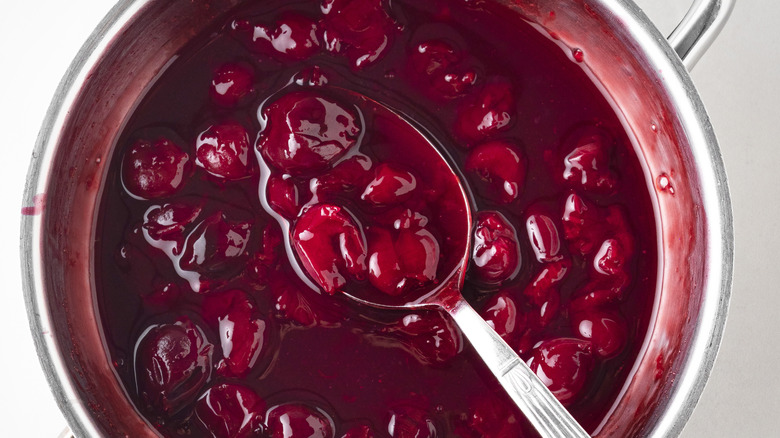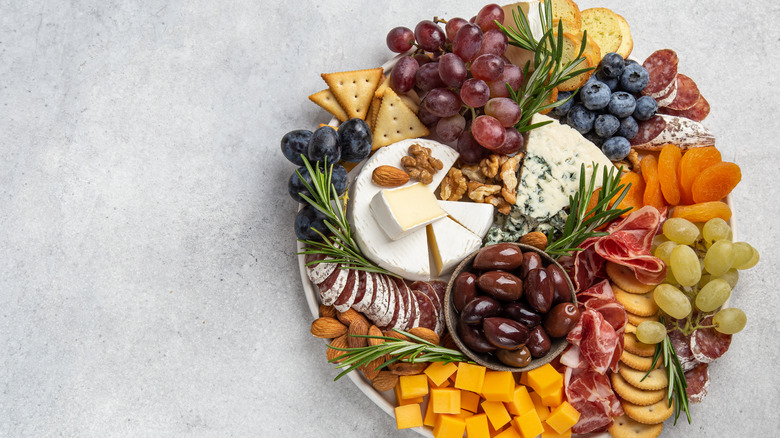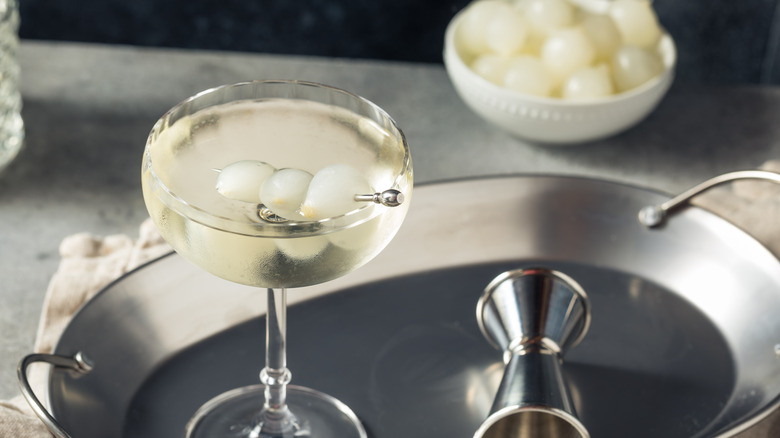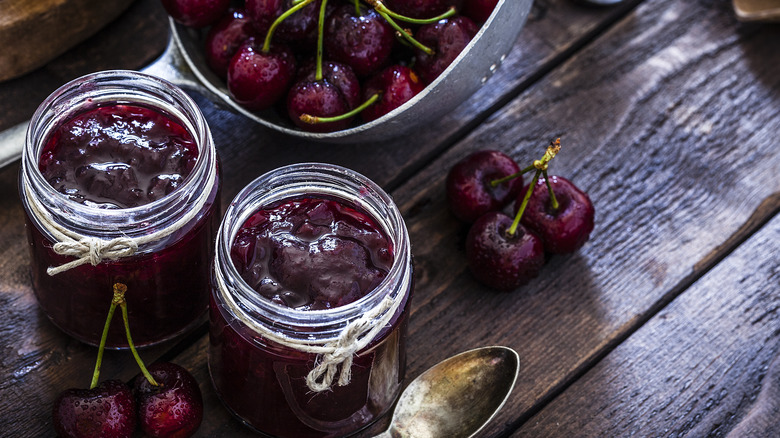Cocktail Onions Vs. Cherries: When To Use Either
At bars across the world, there are a few essentials that bartenders stock up on in anticipation of thirsty patrons. Two of the most common to fill that mise-en-place? Cherries and cocktail onions.
On the surface, these two ingredients couldn't be more different. One is garishly red and the other a ghostly white; one is a drink and dessert staple, and the other an elusive garnish. But these two ingredients, different and incompatible as they may seem, both appear in a large percentage of drinks available at dive bars and ritzy cocktail destinations alike. In cocktails, onions and cherries anchor two different schools of thought around beverage garnishes: the sweet and the savory. Though their polarity is undeniable, the possibilities of what to do with both cherries and cocktail onions are as vast and unexpected as they are divergent. At times, they are even intersecting.
But to wrap one's head around these mainstays can be a bit much. What are the major differences between bar cherries and cocktail onions? How do they differ, and how exactly do they align? How can you use either? From classic cocktails to inventive savory dishes, there is so much to discover about cocktail cherries and onions.
What are cocktail onions and what is their history?
Perhaps the most enigmatic of bar garnishes is the cocktail onions. Stroll through any supermarket jar aisle, and one will see row after row of tiny white bulbs. But odds are you haven't often gone out of your way to pick up a jar for use at home. So, what exactly are cocktail onions?
These tiny orbs of intense flavor are pearl onions, sometimes known as silverskin, baby, and button onions, and are pickled in brine. They often hail from western and northern Europe. The general flavor of a pearl onion before it becomes a cocktail onion is sweet and mildly tangy. Once pickled, sometimes with the inclusion of spices like paprika and turmeric, the cocktail onion is created. Its natural sweetness makes it a suitable choice for inclusion in cocktails because digestion is not hampered. And they are crunchy!
But the cocktail onion's origins are far murkier than what one would expect for a notorious bar staple. Its invention was most likely the result of a preservative measure. Its first appearance as a bar garnish is closely tied to the Gibson martini, in which a green olive is swapped for a cocktail onion. And the initial appearance of the Gibson? Also hard to pinpoint, but its first published recipe appears in a 1908 cocktail recipe book titled "The World's Cocktail and How to Mix Them" by William "Cocktail" Boothby.
What are bar cherries and what is their back story?
When we think of cherries as they relate to bars and beverages, most likely, we're thinking about maraschino cherries. The bright red garnish (or treat) has its origins in Dalmatia, a region in modern-day Croatia. Similar to the cocktail onion, it was invented as a way to extend cherries' longevity through the off-season. These cherries, however, were soaked in alcohol.
When the maraschino eventually made its way over to the United States at the tail-end of the 19th century, Prohibition was well on its way. It eventually compelled regulators to weed out the boozy little cherries, thus creating a need to find an alternative. Thanks to a clever scientist working against that challenge, the world now has its standard, candied maraschino cherries.
The modern bar cherry is preserved in brine, infused with sugar syrup, and dyed that unmistakable bright red. The original choice for the maraschino was the marasca cherry, found in Dalmatia, and the cherries were brined in local seawater. However, the solution is nowadays less romantic and more scientific, involving sulfur dioxide, calcium chloride, and citric acid. This modern variation, common to sundaes and whisky sours, alike retains very little fruit-forward cherry flavor.
Best kinds of cocktail onions
You'll see a few brands repeat themselves in grocery and liquor store aisles. Among the most common are Mezzetta, Divina, and Regal, plus countless more varieties available online. These are generally your standard pickled pearl onions, though, as mentioned, the name of the onion could vary slightly. The only major difference you'll find between brands pertains to the sourcing, brine, and pickling flavor profiles. Some will incorporate different kinds of vinegar, for example.
For jarred cocktail onions that are a little out of the box, Haywards produces a hot and spicy variety. The Dutch brand Filthy offers jars of hand-picked, non-GMO silverskin onions at a slightly higher price point. And for those who don't mind forgetting half the night, Sable & Rosenfeld offer "tipsy" onions, which rest in French vermouth, ready for the snacking or the garnishing. (Crunchy and boozy and bite-sized — what could go wrong?) These tipsy onions also come in a jalapeño-stuffed variety, uniting brine goodness and a spice factor.
For the trepidatious, Mezzetta is a bastion of bar staples for a reason. The can't-go-wrong brand aces both consistency and overall taste. While these standard jarred cocktail onions are practically foolproof, the best kinds may be the ones made at home, where trial-and-error can work their magic.
Best types of cocktail cherries
Because cherries are so consequential to bar culture as a whole, there are so very many versions of cocktail cherries to love. Starting from the basics, the standard non-alcoholic cherry is the maraschino. Among the most common brands used at bars are Regal and Pennant, but they can also be easily purchased. These are the candied varieties that, while they certainly have their place, aren't exactly the most dynamic in flavor or texture. That's where the beloved Luxardo maraschino cherry comes in.
Though known as an Italian good, these cherries hail from what is now Croatia (historically a part of Italy, and then of Napoleon's France, and so on). So deep red they're almost black, the Luxardo preserves a fruity, nutty flavor in a thick marasca cherry syrup. Luxardo cherries are so special that they can often cost $20 or more for a jar or tin.
And then there are the alcoholic cherries. Boozy cherries are among life's greatest delights, and there are more than just the standard bourbon cherry to indulge in. Try red-wine-infused cherries, amaretto cherries, grappa cherries, or brandied cherries.
When to use cocktail onions
When is the right moment to reach for the jar of cocktail onions? One simple rule of thumb is that a cocktail onion makes a great complement to savory cocktails, adding umami and tangy notes. As mentioned, the single defining drink that is equated with cocktail onions is the Gibson. But what is a Gibson? It's a cousin to the drink of the moment — the martini — consisting of gin, dry vermouth, and a pickled cocktail onion. Another common spot for a cocktail onion is in the Bloody Mary, the polarizing brunch favorite. Cocktail onions work well stacked on a toothpick with other savory ingredients like green olives, seafood, and celery.
DIY cornichon Tiny-Tinis are a great way to dabble in the savory and briny cocktail game without having to commit to quantity. In a small glass, add a splash or two of the juice from a quality jar of small cornichons, some ice-cold vodka, and a few cocktail onions from the bottom of the jar for a refreshing aperitif.
One need not limit themselves to only savory cocktails when considering the cocktail onion. Adding cocktail onions to tropical flavors is a way to add interesting dimensions to your drinks. Try it with tequila and pineapple or mango. Onion desserts are certainly a thing, and as such, you should feel free to try your hand at including sweeter varieties of pickled onions in drinks with saccharine profiles as well.
When to use bar cherries
The drinks that demand cherries are so plentiful that it at first seems silly to even ponder its uses in beverages. But whether you want to revisit the classic or consider new courses for your bar cherry inclusion, it's worth a second look.
The classic cocktails that call for a cherry include everything from the stoic Manhattan and Old Fashioned to the more light-hearted Singapore Sling and Tequila Sunrise. Whiskey sours also typically take a cherry on top, as do blue Hawaiians and most amaretto sours. In many cases, the cocktail cherry serves as a complimentary garnish to the sweetness of amaros, brown liquors, and acidic fruit juices. But that's the brilliant thing about cherries as a bar staple: they go with just about everything, and the many varieties of cherries reiterate that reality all the more so.
For something a little sharper, try adding cherries to a Moscow Mule or ginger-based drink. Cognac is also a good spot for a cherry. You can brighten cocktails that don't traditionally include cherry flavors with a splash of cherry juice and a Luxardo or bourbon cherry. Consider them in a Negroni or a martini (to pose an alternative to the lychee martini).
Can you substitute one for another?
Though the cocktail onion and cherry seem to inhabit two completely different spaces within the world of cocktails, there are a few drinks where swapping one for the other can yield tremendous results. But it's no simple plug-and-play. For example, look at the defining uses for both. A cherry plopped into a gin and sweet vermouth martini? Quite a good idea. A cherry plopped into a Bloody Mary? Not as much.
The onion comes into play in a similar way. The idea of a cocktail onion with whiskey or bourbon is a little sickening, while the thought of an onion speared on a toothpick as a garnish for a sweet, tropical drink that might reasonably get a cherry is plausible enough. As a good rule of thumb, do not substitute cocktail onions and cherries for one another indiscriminately. The simplest bases will tend to be more forgiving of both the sweetness of cherries and the tang of cocktail onions, and that is where it would be wise to start.
Non-alcoholic ways to use cocktail onions and cherries
For those who either don't drink or who would simply enjoy taste-testing cherry and cocktail onion beverages sans the buzz, there is a diverse portfolio of drinks with which to do so.
For the cocktail onion, the most obvious first course of action would be the non-alcoholic, or virgin, Bloody Mary. Try drinkable, bottled gazpacho for savory beverage alternatives, which would benefit from a crunchy, tangy garnish like a cocktail onion. Bovril, a beef-based staple of British beverage, can also lend itself to some unique, savory iced beverages. Additions to the Bloody Mary tradition, like Worcestershire sauce and briney garnishes, like pickles and cocktail onions, are ideal.
Cherries are a little easier. Cherries typically adorn classic non-alcoholic drinks like the Shirley Temple (Sprite and grenadine) and a Roy Rogers (cola and grenadine). But beyond the conventional, cherries are your way to shine with non-alcoholic cocktails. During summer, varieties of maraschino cherries could punctuate homemade lemonade, ginger beers, and elderflower mocktails to stay refreshed on hot days. Come winter, try cherries, or even the leftover Luxardo syrup, in your apple cider, cold or hot, or in a rich cup of thick Belgian hot cocoa.
Non-beverage ways to use cocktail onions and bar cherries
If you thought maraschino cherries and cocktail onions only belong on top of and mixed into drinks, think again. The magnificent natural flavors of cherries and onions, that are then treated and transformed into a whole other level of nuance, lend themselves quite well to certain dishes as well.
The easiest place to start is the dessert category. Cherries have always been used in scores of desserts, and maraschinos, even boozy cherries, are no exception. Cherry bundt cakes, tarts, and filled pastries are cherry no-brainers. As far as cocktail onions go, a Texas sweet onion pudding or squash with sweet, cheesy custard is a great place to add some crunchy tang.
Savory dishes also present an opportunity for the two to join forces. Bruschetta with Luxardo cherries, or a cheese and cherries salad, are simple starting points with endless upgrades. Try cocktail onions in dishes that require a mellow pungency. English peas, stews, and succulent roasts all make for good dishes to go with your Gibson.
When to combine cocktail onions and cherries
Relishes. Chutneys. Salsas. The dishes that unite cherries and cocktail onions are those that are the ones that echo each other across food cultures. And they're quite easy to execute as well.
Savory dishes are the strongest angle to attempt uniting cocktail onions and maraschino cherries. Take the relish for example, which can evoke either holiday coziness or summer refreshment. All one needs are onions and cherries, oil and butter, red pepper flakes, brown sugar, and salt to taste. Cherry onion jam is also a documented success on burgers, so try the relish or other sauce-like transformation of the two ingredients atop your beef patty. Both cocktail onions and cherries benefit from spices and herbs like thyme and rosemary, further bolstering their compatibility.
But the simplest way to combine bar cherries and cocktail onions in a successful non-beverage way? Take to the charcuterie board. Dress the board with Luxardos, brandied cherries, and fresh cherries, plus a small bowl of cocktail onions, some classic pearl and others homemade pickled spring onions, and a spread of top-notch cheeses for a fruity, nutty, tangy, boozy board that's sure to be social-media-friendly.
How to make at-home cocktail onions
The key to the things we pickle is brine and the pickling seasonings. At its simplest, brine is water with a high-concentration solution of salt. There are other components to the brine that one can incorporate, like rice wine vinegar and sugar, but most of the flavoring is going to come from the pickling seasoning mix you craft.
Though really, creating cocktail onions is an easy process ripe with potential for customization. The first step in creating your own is to get your pearl onions (though part of the customization can also be the varietals of onions used, from red onions to shallots). Cooking together brine, salt, sugar, and seasoning of choice, then sealing away the jar for at least two days, you have the basics of cocktail onion creation. The seasoning mix it gets cooked in can contain mustard seed, fennel, turmeric, paprika, and anything you'd like to add to punch up the mellow kick of pearl onions.
How to nail homemade maraschino cherries
Making your own maraschino cherries at home is the ultimate step in achieving amateur bartender status and becoming the resident cocktail savant of the friend group. Luckily, they are incredibly easy to make.
All one needs to make at-home maraschino cherries are the following: maraschino liqueur, cherries, sugar, and cherry juice. Maraschino liqueur, also originally the creation of Dalmatian monks, is available under the Luxardo brand and is available at most liquor stores. As far as equipment goes, a cherry pitter, measuring cups, a pan, and a mason jar will do the trick.
Simply cook the cherries on medium-high heat for a few minutes in the solution and press them down to incorporate the flavors fully. All that's left is to store and soak for a few days. For a cozier take, add cognac or brandy, and warming spices like cloves and cardamom. Cherries complement so many different flavors, that even simply soaking them in vodka and sugar, brandy simple syrup, Frangelico, and dry sherry will yield mouth-watering results.
